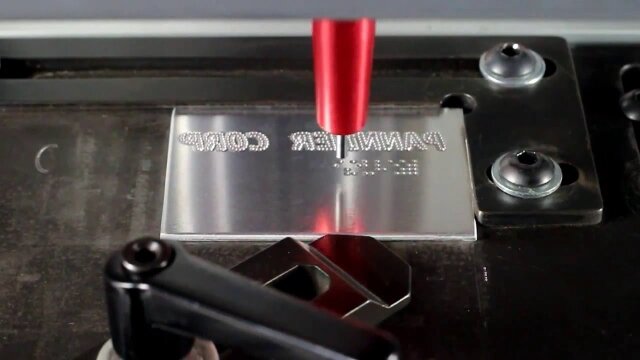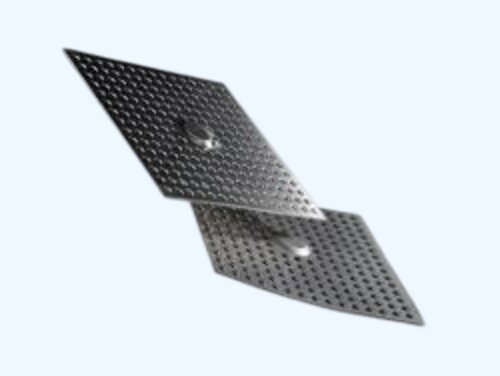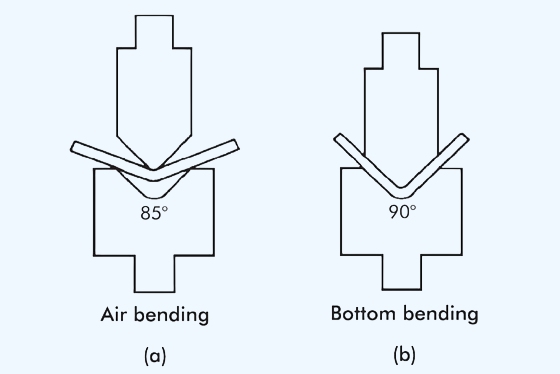Every product needs a unique identity — a serial number, barcode, or logo that connects it to design data and service records. In industries like energy storage, medical devices, and sheet-metal assembly, marking is more than a label; it is a quality assurance step that supports traceability and regulatory compliance.
Two technologies dominate metal marking today: laser marking and dot peen marking. Both can engrave codes and logos permanently, yet they work in very different ways. Understanding these differences is the first step in choosing the method that fits your factory’s workflow.

How Laser Marking Works?
Laser marking uses a focused beam of light to alter the material surface. Depending on beam power and pulse duration, it can etch, engrave, or anneal the top layer of metal or plastic. Because the process is non-contact, no tool touches the part, which means no wear, no vibration, and no surface deformation.
| Laser Type | Typical Wavelength | Best for Materials |
|---|---|---|
| Fiber Laser | 1064 nm | Stainless steel 304/316, aluminum 5052, brass |
| CO₂ Laser | 10.6 µm | Plastics, coated metals, wood |
| UV Laser | 355 nm | Electronics, anodized aluminum, delicate polymers |
Design Tip: For stainless steel or aluminum panels, set laser power around 15–25 W and reduce scan speed for strong contrast without affecting surface smoothness.
Modern fiber lasers operate continuously for up to 100,000 hours and connect directly to ERP or barcode databases. This integration makes them ideal for high-volume sheet-metal production lines that need fast and consistent marking.

How Dot Peen Marking Works?
Dot peen marking creates a pattern of tiny indentations on the surface using a hard carbide stylus. Each impact forms a dot; a series of dots builds letters, numbers, or data codes. The mark is mechanically engraved into the material, making it deep and resistant to abrasion, heat, or paint.
Because the stylus moves along X-Y axes while the part stays still, it is especially effective on rough, oily, or cast surfaces where lasers lose focus. It also handles hard metals like carbon steel and titanium without losing depth or legibility.
Standard Error: Insufficient clamping during dot peen operation causes uneven dot spacing and stylus bounce. Always secure the workpiece firmly to maintain uniform depth.
Design Tip: When marking thick carbon steel, set the impact depth to 0.2–0.3 mm for readability after painting or galvanizing.

Laser vs Dot Peen Marking: Key Comparison Factors
Choosing between laser and dot peen marking depends on more than appearance. Let’s compare how they differ in precision, durability, cost, and automation readiness.
Marking Quality and Precision
Laser marking delivers sharp, high-contrast results with line widths as small as 0.02 mm. It reproduces complex logos, barcodes, and QR codes without distortion. This precision makes it ideal for branding surfaces, serial numbers, and compliance data that must remain visually consistent.
Dot peen marking, however, forms a pattern of physical dots. The marks are durable but not as crisp. For industrial parts where appearance is secondary, their tactile texture can even help operators feel or read serial numbers under poor lighting.
💡 Design Tip: For laser-readable QR codes, use laser marking; scanners capture smooth, high-contrast marks faster than uneven dots.
Material Compatibility and Surface Condition
Laser marking can process metals, plastics, ceramics, and coated finishes. With proper beam settings, it can mark anodized aluminum, black-oxide steel, or powder-coated panels.
Dot peen excels on hard, rough, or unpolished surfaces — such as cast iron, carbon steel, Q235, or forged parts. It penetrates where lasers might lose focus or create inconsistent contrast.
⚠️ Common Error: Using laser marking on sand-cast or textured surfaces leads to patchy marks. Choose dot peen when the surface finish is uneven.
Depth, Durability, and Resistance to Post-Processing
Laser marks are typically 0.01–0.05 mm deep — perfect for identification, but sometimes shallow for thick coatings. When powder coating exceeds 60 µm, increase laser power or mark before coating to maintain visibility.
Dot peen marks can reach 0.1–0.5 mm depth, staying legible after painting, plating, or heat treatment. They resist corrosion, abrasion, and cleaning cycles for years, even in harsh environments.
💡 Design Tip: If your parts are coated, test both methods on a finished sample. Measure readability after coating and select the process with the best contrast.
Speed and Automation Potential
Laser marking is faster and easier to automate. Because there’s no mechanical contact, cycle time per mark can be under 1 second for small fonts. Multi-axis systems integrate directly with conveyors or robotic arms, making laser the best choice for continuous production.
Dot peen marking is mechanical; the stylus must travel dot by dot. Complex patterns take longer — typically 3–6 seconds per code. For low-volume production or stand-alone workstations, this slower speed is acceptable.
⚙️ Efficiency Note: In high-volume lines, laser marking can triple output speed and reduce setup time by eliminating stylus wear adjustments.
Equipment Cost and Maintenance
Laser systems have a higher initial investment due to optics and the beam source. Yet, their maintenance costs remain minimal: no consumables, no stylus replacement, and a long lifespan (> 100,000 hours).
Dot peen machines cost less to purchase but need frequent stylus changes, especially on hard metals. Air-driven units require regular filter cleaning and lubrication. For small shops or occasional marketing, this can still be more economical in the short term.
💡 ROI Tip: For production volumes above 5,000 parts per month, the lower operating cost of laser marking usually offsets its initial price within 1–2 years.
Environmental and Operator Safety
Laser marking requires fume extraction and protective enclosures to block reflected light. When properly installed, it operates quietly and cleanly under Class 1 safety standards.
Dot peen creates noise and vibration. Continuous operation can reach 80–90 dB, so sound-insulated enclosures or mounts are recommended for shared workspaces.
🧱 Design Tip: For open workshops with heavy equipment, dot peen fits naturally. For labs or assembly lines requiring clean conditions, laser marking keeps the area dust-free and quiet.
Quick Comparison Snapshot
| Factor | Laser Marking | Dot Peen Marking |
|---|---|---|
| Mark Quality / Contrast | ★★★★★ High precision | ★★☆☆☆ Rugged, low detail |
| Depth / Durability | ★★★☆☆ | ★★★★★ |
| Material Range | ★★★★★ | ★★★☆☆ |
| Surface Tolerance | ★★☆☆☆ | ★★★★★ |
| Speed / Automation | ★★★★★ | ★★☆☆☆ |
| Initial Cost | ★★★☆☆ | ★★★★★ |
| Maintenance Cost | ★★★★★ | ★★☆☆☆ |
| Operator Safety | ★★★★☆ | ★★★☆☆ |
Choosing by Application and Industry
Both marking systems serve distinct needs. The best choice depends on how the part is used, what environment it faces, and how readable the mark must remain over time. Below are the main industrial use cases and how each technology fits within them.
Heavy-Duty and Structural Components
Dot peen marking is the top choice for automotive, construction, and industrial machinery parts. Its deep mechanical marks stay visible through heat, vibration, and abrasion. The stylus penetrates thick coatings, making it suitable for steel frames, chassis brackets, and forged housings.
Because dot peen marking is impact-based, it performs reliably on rough, oily, or unmachined surfaces, where lasers often struggle to focus. It also remains legible even after galvanizing or painting — a key advantage for long-service components.
💡 Design Tip: For cast or welded structures, leave a flat 20×20 mm area for marking. It ensures consistent stylus contact and uniform depth.
⚠️ Common Error: Overlapping weld seams near the marking area can deflect the stylus and cause shallow dots. Keep at least 10 mm clearance between welds and marking zones.
Precision and Branded Components
Laser marking dominates in medical devices, consumer electronics, and sheet metal enclosures. These industries prioritize clarity, traceability, and aesthetic quality.
A focused laser can engrave text, serial numbers, or 2D codes as small as 0.2 mm, maintaining sharp edges even on anodized or brushed aluminum.
The non-contact process prevents distortion of thin sheet metal and keeps the finish intact — crucial for visible surfaces or logo areas. With computer-controlled parameters, operators can switch designs instantly, enabling flexible production across multiple product variants.
💡 Design Tip: For brushed or powder-coated aluminum panels, use a fiber laser around 1064 nm wavelength. It creates dark, high-contrast marks without burning the surrounding finish.
Traceability and Compliance-Driven Manufacturing
In industries governed by ISO 9001, IATF 16949, or FDA traceability requirements, laser marking is the preferred solution. Its high precision allows machine-readable QR codes, DataMatrix symbols, and UIDs that connect directly to production databases.
While dot peen can also encode serials, optical scanners may struggle with uneven dots or worn marks, especially after coating or polishing. For global suppliers and exporters, a laser-based system provides better consistency in automated inspection and traceability workflows.
📊 Verification Tip: Always validate your code readability after surface finishing using a standard scanner or vision system. Ensure the code meets Grade B or higher under ISO 29158 (AIM DPM) verification.
Industry Example Table
| Industry | Preferred Method | Reason |
|---|---|---|
| Automotive and Heavy Equipment | Dot Peen | Deep, rugged marks resist wear and coating |
| Medical Devices | Laser | High-contrast, contamination-free identification |
| Consumer Electronics | Laser | Precise branding and small part marking |
| Aerospace | Laser | Lightweight parts, strict traceability |
| Metal Fabrication / Construction | Dot Peen | Works on large, rough surfaces and steel frames |
| Energy Storage / Batteries | Laser | Clean marks compatible with sealed enclosures |
Hidden Considerations
Beyond surface quality and speed, hidden factors shape actual marking value. From coatings to ROI, here’s what determines which method fits your workflow best.
How Surface Finishes and Coatings Affect Marking?
Surface finishing often decides which marking method lasts. Powder coating, anodizing, and plating can reduce contrast or fill shallow marks.
Laser marks are usually 0.02–0.05 mm deep, perfect for uncoated metals. Yet thick coatings (> 60 µm) may blur visibility unless the beam engraves deeper or marks before finishing. Some systems can ablate the layer to reveal the bare metal for better contrast.
Dot peen marks, typically 0.2–0.5 mm deep, stay readable after coating or polishing because the stylus creates an indentation rather than a color change. That depth makes it reliable for parts exposed to abrasion, corrosion, or repeated cleaning.
💡 Design Tip: Always test marking readability after coating. Compare laser and dot peen samples under factory lighting and scanning distance.
Marking on Curved or Complex Geometries
Laser marking requires a stable focus distance. On curved or angled parts, the beam may distort unless the system includes auto-focus or multi-axis galvo heads. These upgrades increase cost but improve consistency for 3D surfaces.
Dot peen handles curves naturally. The stylus can follow cylindrical or irregular surfaces like shafts, pipes, or brackets without losing depth. For thick metal housings or structural components, it’s often simpler to program and maintain.
⚙️ Engineering Tip: For thin sheet-metal enclosures, avoid dot peen impact near bends or rivets; vibration can deform the panel. Use laser marking instead.
Long-Term Readability and Data Retention
When parts face heat, vibration, or corrosion, mechanical marks last longer, and dot peen remains legible even after years of use in outdoor or industrial settings.
Laser marks excel in clean or controlled environments—electronics, medical, or energy-storage systems—where contrast and machine readability matter more than depth. Their smooth surface also resists dirt buildup, helping scanners maintain accuracy.
🧩 Verification Action: Test QR or DataMatrix readability after environmental cycling or salt-spray testing. Ensure marks still meet traceability standards under ISO 29158.
ROI and Lifecycle Cost Analysis
Up-front and long-term costs differ sharply:
- Laser Marking: Higher purchase cost but minimal maintenance. No stylus wear, no consumables, and cycle times 2–3× faster. Ideal for high-volume or automated lines.
- Dot Peen Marking: Lower entry cost but higher operating expenses. Stylus wear, compressed-air maintenance, and slower throughput increase total cost over time.
In many cases, once production exceeds 5,000–10,000 parts per month, laser marking achieves a faster return on investment thanks to lower downtime and labor savings.
💡 ROI Tip: Include maintenance hours, stylus replacement, and production yield in your cost model—not just machine price. Real savings come from uptime and process reliability.
Final Checklist: Which Method Fits Your Workflow
✅ If your parts are coated, forged, or rough → Dot Peen
✅ If your parts need branding, traceability, or micro-codes → Laser
✅ If your production line is automated → Laser
✅ If you run low-volume heavy-duty jobs → Dot Peen
✅ If you plan for multi-material flexibility → Laser
Both systems can coexist in one facility. Many manufacturers use laser marking for visible logos and dot peen for deep serials on structural parts, combining efficiency with durability.
Conclusion
Laser and dot peen marking each bring clear advantages. Laser delivers precision, speed, and clean integration with digital traceability systems. Dot peen provides depth, endurance, and performance on rough or coated metals.
The best solution depends on your materials, coatings, and workflow. Evaluating them early in the design or DFM phase ensures each mark stays legible through the product’s entire lifecycle.
At Shengen, our engineers help manufacturers choose and implement marking systems that fit their materials, finish, and volume needs. Upload your drawing or request a free DFM review.
FAQs
Which method produces the deepest mark?
Dot peen marking forms mechanical indentations up to 0.5 mm deep, making it highly durable. Laser marks are shallower but provide cleaner visual contrast.
Can laser marks survive powder coating?
Yes, if engraved before coating or with increased beam power. Always test visibility after curing to confirm clarity.
Which is faster for automated lines?
Laser marking is faster and easier to automate, completing minor marks in under a second. Dot peen takes longer due to mechanical motion.
How often should a dot peen stylus be replaced?
Typically, every one to three months, depending on part hardness and marking depth.
Which is better for traceability?
Laser marking produces sharper, machine-readable codes like QR or DataMatrix, ideal for automated tracking and digital traceability systems.
Hey, I'm Kevin Lee

For the past 10 years, I’ve been immersed in various forms of sheet metal fabrication, sharing cool insights here from my experiences across diverse workshops.
Get in touch

Kevin Lee
I have over ten years of professional experience in sheet metal fabrication, specializing in laser cutting, bending, welding, and surface treatment techniques. As the Technical Director at Shengen, I am committed to solving complex manufacturing challenges and driving innovation and quality in each project.




